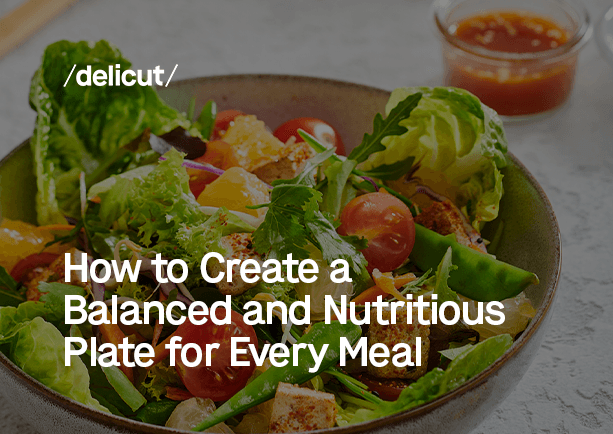How to Create a Balanced and Nutritious Plate for Every Meal

When it comes to maintaining a healthy lifestyle, one of the key factors is creating balanced and nutritious meals. But with so much information out there, it can be overwhelming to know what truly constitutes a well-rounded plate.
In this blog, we will unravel the secrets of crafting a balanced and nutritious plate for every meal, empowering you to make informed food choices that nourish your body and support your well-being.
From understanding portion sizes to incorporating a variety of food groups, we will provide you with practical tips and insights to help you create delicious meals packed with the essential nutrients your body needs.
What is a Balanced Meal?
A balanced meal refers to a meal that contains a variety of nutrients in appropriate proportions to meet the body's nutritional needs. It typically consists of a combination of macronutrients (carbohydrates, proteins, and fats) along with essential vitamins, minerals, and fiber.
A balanced meal provides sufficient energy, supports proper bodily functions, and helps maintain overall health.
The Importance of Creating a Balanced Plate for Meals
Creating a balanced plate for every meal is an essential part of maintaining your health and overall well-being. Here are a few reasons that highlight the importance of creating a balanced meal plate:
- Provides essential nutrients for overall health.
- Sustains energy levels and prevents crashes.
- Supports weight management and portion control.
- Promotes digestive health and a healthy gut.
- Reduces the risk of chronic diseases.
- Enhances mental well-being and cognitive function.
Creating a Balanced and Nutritious Plate for Every Meal
Are you looking to improve your overall health and well-being through your daily meals? Creating a balanced and nutritious meal is the key to achieving that goal.
By understanding the principles of balance and incorporating various nutrient-rich foods, you can ensure your body receives the essential vitamins, minerals, and energy it needs. Here are a few tips that will help you craft that perfect and balanced meal plate:
Non-starchy Vegetables
Fill half of your plate with non-starchy vegetables. Aim for a variety of colorful vegetables to maximize nutrient intake. Include options like broccoli, spinach, kale, bell peppers, zucchini, or cauliflower. These vegetables are low in calories and high in vitamins, minerals, and fiber.
Lean Protein Sources
Reserve a quarter of your plate for lean protein sources. Choose lean cuts of meat, poultry, or fish, or opt for plant-based proteins like tofu, tempeh, beans, lentils, or chickpeas. These protein sources provide essential amino acids, vitamins, and minerals without excessive saturated fat.
Whole Grains and Starchy Vegetables
Dedicate the remaining quarter to whole grains or starchy vegetables. Include whole grains such as quinoa, brown rice, whole wheat bread, or whole grain pasta. Alternatively, opt for starchy vegetables like sweet potatoes, corn, or butternut squash. These options provide complex carbohydrates for sustained energy and dietary fibre.
Healthy Fats
Include a small serving of healthy fats. Incorporate sources of healthy fats such as avocados, nuts, seeds, olive oil, or fatty fish like salmon. These fats support brain health, provide essential fatty acids and aid in absorbing fat-soluble vitamins.
Natural Sweeteners and Seasonings
Add a serving of fresh fruit or a small portion of low-sugar dairy products for added nutrients and natural sweetness. Use herbs, spices, and seasonings to enhance the flavor of your meals instead of relying on excessive salt or sugar.
Portion Control
Pay attention to portion sizes to maintain a balance of nutrients and prevent overeating. Use visual cues, measuring tools, or your hand as a guide. For example, a serving of protein should be about the size of your palm, and a serving of grains or starchy vegetables can fit in your cupped hand.
Mindful Eating
Practice mindful eating by slowing down, savoring each bite, and paying attention to your body's hunger and fullness cues. This can help prevent overeating and promote a healthier relationship with food.
By incorporating these tips into your meal planning, you can create balanced and nutritious meal plates that provide a variety of essential nutrients, support energy levels, and contribute to overall well-being.
Conclusion
Creating a balanced and nutritious plate for every meal is a powerful way to nourish your body, support optimal health, and enjoy a variety of delicious flavors. This balanced approach provides sustained energy, aids in weight management, promotes digestive health, and reduces the risk of chronic diseases.
Remember that creating a balanced plate is not about strict rules or deprivation but rather about finding harmony and enjoyment in your meals. So, embrace the colorful array of foods available to you, get creative in the kitchen, and embark on a journey of crafting balanced and nutritious meals that will nourish your body and contribute to your overall well-being.
FAQs
1. What does a balanced and nutritious plate consist of?
A balanced and nutritious plate consists of non-starchy vegetables filling half the plate, a quarter for lean protein, another quarter for whole grains or starchy vegetables, and a small serving of healthy fats. Optional additions include fruits or low-sugar dairy products.
2. Why is it important to create a balanced plate for every meal?
Creating a balanced plate for every meal is important because it ensures that you receive a variety of essential nutrients, maintain steady energy levels, support weight management, promote digestive health, reduce the risk of chronic diseases, and contribute to overall well-being.
3. How can I incorporate more vegetables into my meals to create a balanced plate?
To incorporate more vegetables into your meals and create a balanced plate, try adding them to dishes like stir-fries, salads, soups, or omelettes. Include a variety of colorful vegetables and experiment with different cooking methods such as roasting, sautéing, or steaming.
You can also substitute grains or pasta with vegetable alternatives like zucchini noodles or cauliflower rice. Snack on raw vegetables with hummus or include them in wraps and sandwiches. Adding vegetables to smoothies or blending them into sauces and dips is another creative way to boost your vegetable intake.
4. Can I still enjoy carbohydrates on a balanced plate, especially if I'm trying to manage my weight?
Yes, you can still enjoy carbohydrates on a balanced plate, even if you're managing your weight. Opt for complex carbohydrates like whole grains, quinoa, brown rice, or sweet potatoes, which provide fibre and are digested more slowly, keeping you fuller for longer.
Be mindful of portion sizes and focus on including more non-starchy vegetables and lean proteins to create a well-balanced plate. The key is to choose carbohydrates wisely and incorporate them in moderation as part of a balanced meal.
5. Are there any simple tips for creating a balanced plate when dining out or ordering takeout?
Here are some tips for a balanced plate when dining out or ordering takeout:
- Look for options with vegetables, lean proteins, and whole grains.
- Choose grilled or steamed dishes over fried or saucy ones.
- Use dressings and sauces sparingly by requesting them on the side.
- Manage portion sizes by opting for smaller portions or sharing meals.
- Include a side of salad or vegetables for added nutrients.
- Choose water or unsweetened beverages instead of sugary ones.
- Be mindful of extras like bread or desserts.
- Request substitutions like replacing fries with a side salad.
- Read the menu carefully and ask about ingredients or preparation methods.
- Make mindful choices while indulging occasionally.
Related Blogs
DASH Diet Meal Plan
Nov 11, 2025 | 8Fatty Liver Meal Plan
Oct 31, 2025 | 8Pregnancy Diet Meal Plan
Oct 27, 2025 | 82000 Calorie Meal Plan
Oct 1, 2025 | 8Intermittent Fasting Diet Plan
Sep 5, 2025 | 81000 Calorie Meal Plan
Sep 5, 2025 | 8High-Protein Meal Plans
Sep 5, 2025 | 8How to Choose the Right Meal Plan for Your Fitness Goals
Sep 5, 2025 | 8The GM diet plan: Is it possible to shed fat in just 7 days?
Sep 5, 2025 | 815-Day Blood Sugar Control Meal Plan
Aug 30, 2024 | 10






